Brass Instrument Mutes
Trumpet, Trombone, French horn and (even) Tuba
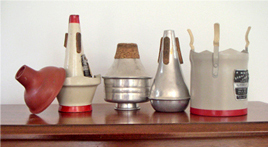 Although the word “mute” may mean silence, a brass instrument mute doesn’t actually silence the brass instrument (much as some might wish it would). A mute changes the sound of the brass instrument in a certain way depending on the type of mute used. Generally, a mute for a brass instrument (trumpet, trombone, French horn, baritone horn, euphonium, tuba, etc) lowers the volume and alters the timbre (tonal quality) of the instrument.
Although the word “mute” may mean silence, a brass instrument mute doesn’t actually silence the brass instrument (much as some might wish it would). A mute changes the sound of the brass instrument in a certain way depending on the type of mute used. Generally, a mute for a brass instrument (trumpet, trombone, French horn, baritone horn, euphonium, tuba, etc) lowers the volume and alters the timbre (tonal quality) of the instrument.
Most mutes go inside the bell of the brass instrument, using cork pressed against the inside of the bell as a means of holding the mute in place. There are some exceptions to this as noted below. It’s sometimes necessary to apply moisture to the cork to hold the mute in place.
Brass instrument mutes are sometimes used in Classical (or “legit”) music, most often in 20th and 21st century pieces. Igor Stravinsky, Gustav Mahler and Paul Hindemith are among the orchestral composers who make use of trumpet mutes in their works.
Brass Mute Sound Samples
However, trumpet and trombone mutes are probably used most often in Jazz music. Mutes can often help trombone and trumpet players blend better with their fellow instrumentalists, particularly in a small jazz ensemble setting. A brass player will also often use a mute to help lower the volume of their instrument when playing with a vocalist.
Trombone and trumpet mutes were (and are) used extensively in Big Band music. According to author George T. Simon, in his excellent Glenn Miller biography entitled “Glenn Miller and His Orchestra” (page 275), as World War 2 was drawing near Miller, not wanting to be short of mutes when the material for their construction was needed for the war effort, bought up 250 of them and stored them in a warehouse, sending for them as he needed them.
If you are a brass student who would like to start using mutes in your playing, you should consult with your private lesson brass teacher for more information on what mutes are right for you.
Brass Instrument Mute Types
There are several different types of brass instrument mutes. Each type of brass instrument mute imparts its own particular sound to the instrument. Variations on the materials as well as the construction of each mute type also affect the volume and timbre of the muted brass instrument.
Straight Mute
Construction Materials: Cardboard, aluminum (sometimes with a copper bottom), wood.
Manufacturers Include: Denis Wick, Tom Crown and Alessi-Vacchiano and Humes & Berg “Stonelined”.
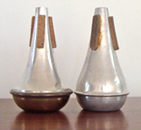
A straight mute is shaped like a cone with the small open end going inside the bell of the brass instrument and the larger, closed end outside. The mute is held in place by three pieces of cork.
This mute produces a kind of stuffy sound when it’s made from cardboard (the “Stonelined” mute) and a more piercing, brighter sound when made out of aluminum. The straight mute recorded example is of a trumpet using a straight mute made from aluminum.
Cup Mute
Construction Materials: Cardboard.
Manufacturers Include: Humes & Berg “Stonelined”.
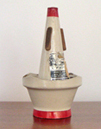
The cup mute is a straight mute with a cup on the end. Rounded edges around the lip of the cup allow air to escape out of the bell. This mute is almost always made from cardboard and is also held in place by three pieces of cork.
A cup mute produces a softer, more muffled sound than the straight mute. The cup mute recorded example is of a trumpet using a cup mute made from cardboard.
Harmon (aka “wah-wah” or “wow-wow”) Mute
Construction Materials: Aluminum.
Manufacturers Include: Harmon, Jo-Ral and Tom Crown.
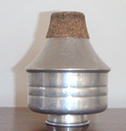
The Harmon mute is almost always made from aluminum. This mute has two parts. The larger part is bell shaped and it held inside the instrument by one continuous piece of cork wrapped around the mute.
The second piece, called a stem, fits inside the first. The mute can be played with the stem all the way inside, part way inside or left out all together.
When reading a jazz chart that calls for a Harmon mute, the printed chart will usually indicate how the stem is to be used as well. The Harmon mute recorded example is of a trumpet using a Harmon mute with the stem out.

This mute is used often in jazz. Trumpeters Miles Davis and Dizzy Gilespie used it extensively. Miles Davis, in particular liked to play his trumpet using the Harmon mute with the stem removed completely from the mute.
The Harmon mute is also known as a “wah-wah” mute. When the brass player uses his or her hand to open and close the end of the mute, it makes a “wah-wah” sound.
Plunger Mute
The plunger mute is most often a regular (new:) bathroom plunger. The mute is not attached to the instrument in any way, but simply held in the player’s left hand.

It’s usually manipulated by the brass player to cover and then uncover the bell of the trumpet or trombone, in a similar manner to the “wah-wah” sound referred to above. However, this mute has none of the metal sounding quality of the Harmon mute.
In the days of the big bands, a plunger mute was often made of cardboard and painted white and red. This was probably because it looked better then using a bathroom plunger, especially in a fancy ballroom setting.
When reading a jazz chart that calls for a plunger mute, an “+” and “O” are often seen. The “+” indicates that the player should cover the bell with the mute (although not all the way) and the “O” means that the bell should be uncovered, although again not all the way uncovered.

Bucket Mute
A bucket mute doesn’t use cork to attach to the instrument, but rather clips onto the outside of the bell with three large spring clips. This mute is made from cardboard and has cotton inside to further muffle the sound.
Other Types of Brass Instrument Mutes
Other brass instrument mutes include the Derby Hat mute (made to look like a derby hat, an interesting visual effect), a Stop mute (used by the French horn) and a Practice mute. A Practice mute is usually used just as its name implies, to muffle the instrument sound so a brass player can practice without disturbing others (as much). This mute is also good for a performer who needs to warm up quietly at the performance venue or a brass player who lives in a condo or apartment. Note that a Practice mute is never used in performance.
The sound clips featured on this page are from an article on Recording Brass Instruments, written by David Summer and published in the November 2004 issue of Electronic Musician magazine. The article also includes sound clips with examples of different microphones used to record brass instruments and suggested microphone placing.
Mutes and Musical Notation
 See more information about taking quality private trumpet lessons from David Summer.
See more information about taking quality private trumpet lessons from David Summer.
Italian is the international language used by musicians when directions are called for in written music. These written musical directions may include tempo markings, dynamics, articulation descriptions, etc. The use of Italian for these directions is especially prevalent in classical music.
“Con sordino” is the Italian translation of “with mute”. In classical music, when the composer or arranger wants to the performer to use a mute, he or she will mark the muted section “con sordino”. This is sometimes abbreviated as con sord, sord or sordino.
Jazz music, on the other hand, often uses the native language. In English, a composer or arranger will indicate a muted section by marking it with the name of the mute to be used. When the performer should remove the mute, the word “Open” is used.
Here are some practical examples of mute notation in jazz music.
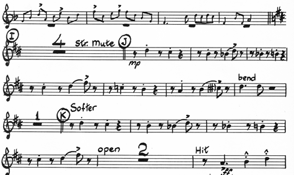
Straight Mute Notation
This is an excerpt from String of Pearls, by Jerry Gray. Although many bands have performed String of Pearls, the best-known version is the one by the legendary Glenn Miller Dance Band.
This excerpt from the Trumpet One part, indicates that the player should use a Straight Mute (here abbreviated “Str. Mute”) starting at letter ‘J’ in the song. Also notice the “Open” marking, 5 bars after letter ‘K’, telling the trumpet player to remove the mute.
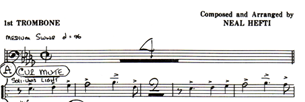
Cup Mute Notation
This is an excerpt from Cute, by Neal Hefti. Besides being an excellent jazz composer, Neal Hefti is well known for his 1970s television tunes.
This excerpt from the Trombone One part indicates that the trombone player should use a Cup Mute at letter ‘A’.
Plunger Mute Notation
This last excerpt is from One O’Clock Jump, by inimitable Count Basie. This excerpt from the Trumpet One part indicates that the trumpet player should use a Plunger or Derby mute (or, his or her hand).

Notice the ‘+’ (plus) and ‘O'(oh) markings above the notes. As noted above, the + sign tells the player to put the plunger over the bell of the trumpet. Conversely, the O sign tells the trumpet player to move the plunger away from the bell.
A good example of brass players using plunger mutes can be heard in the brass background parts of Harlem Nocturne, by Earle Hagan.
Brass Mutes for Students, Which Mute Should I get First?
Since the most commonly used brass instrument mute is the straight mute, this is the one that students should purchase first. Fortunately, almost all brass instrument mutes are relatively inexpensive and the straight mute is generally the least expensive of all.
When teaching the trumpet and trombone, David usually has his brass students start their mute collection with the Humes & Berg “Stonelined” straight mute. This is often obtained in the 9th grade when students reach high school and have the opportunity to play in their school jazz band, or “stage band”.
 The next mute the student should get is a cup mute. Again the Stonelined mute is suggested. After that, the student should pick up a Harmon mute. “Harmon” is the brand name of the mute. A student will generally not have the need for a bucket mute unless it’s required for a specific piece they are performing.
The next mute the student should get is a cup mute. Again the Stonelined mute is suggested. After that, the student should pick up a Harmon mute. “Harmon” is the brand name of the mute. A student will generally not have the need for a bucket mute unless it’s required for a specific piece they are performing.
A plunger can, of course, be obtained on any trip to the hardware store. Just don’t tell them what it’s for, they look at you funny. Get a smaller one for the trumpet and a larger one for the trombone.
A practice mute may be useful if a student lives in an apartment. Be aware though that students should not be consistently practicing using a practice mute because it does change the natural “resistance” felt by blowing into a brass instrument.
Coda
Although mutes are most often used with brass instruments, string instruments and to an even lesser extent woodwinds also have mutes made for them.
String instrument mutes are attached to the bridge of the string instrument. As with brass mutes, string instrument mutes (for violin, viola, cello and bass) make the instrument sound softer. However, they don’t change the timbre of the instrument as much as brass mutes do.
Again, if you are a brass student who would like to start using mutes in your playing, you should consult with your private lesson music teacher for more information on what mutes are right for you.
You may also be interested in David’s Selected Duets for Trumpet Podcast.